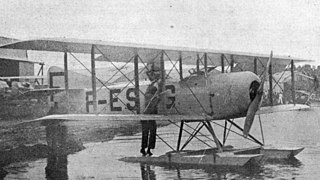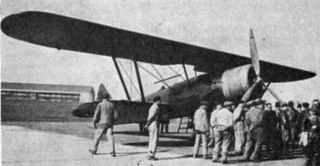Operators

| Caudron C.97 | |
|---|---|
| Role | Trainer |
| National origin | France |
| Manufacturer | Caudron |
| First flight | early 1924 |
The Caudron C.97 was a two-seat biplane trainer designed and built in France around 1924. A number were used by the Bolivian Air Force.
Rather little information has survived on the C.97. [1] Although it looked very similar to the Caudron C.59 and used the same engine, it is not on a list of eight other Caudron designs which shared the latter's airframe. [2] The C.97 was a two bay biplane without stagger and with pairs of parallel interplane struts and cabane struts. Its fabric covered, unequal span wings were rectangular in plan apart from a large central cut-out over the fuselage to improve upward vision from the rear cockpit. Ailerons were fitted to the upper wing. [1]
Its fuselage was flat sided. An upright, water-cooled Hispano-Suiza 8Ab V-8 engine, a relatively high compression engine developed during World War I as aircraft flew to higher altitudes [3] and so able to cope with the high Andean airfields of Bolivia, sat high in the nose with the fuselage underside curving upwards under it and with a flat fronted, angled cowling above the propeller shaft. Two different radiators were used, one of the cylindrical Lamblin type mounted below the fuselage and the other a shallow but wide rectangular one on the underside. The forward open cockpit was close behind the engine and under the wing, with the instructor's position slightly behind the trailing edge. At the rear the fin was triangular and broad, with a straight edged rudder that reached down to the keel. Since the tailplane was mounted on top of the fuselage, the elevators had a large cut-out for rudder movement. [1]
The C.97 had a fixed tail skid undercarriage with its mainwheels on a single axle sprung from V-form struts to the lower fuselage longerons. [1]
The first flight was probably made in early 1924 as the prototype was registered F-AGBH in April that year. [4] The first Bolivian Air Force machine was delivered on 1 August 1925. [1] The number purchased is not known; L'Aéronautique in 1927 mentions just one [5] but Flight in 1928 says "a number". [6] One C.97 was used from mid-1926 by the French-South American Company, based in Buenos Aires in Argentina. [7] The privately owned F-AGBH flew in France until 1926, taking part in competitions like the 1924 Concours Aviation de Tourisme de l'Aéro-Club de France (aviation touring competition of the French Aéro-Club). [4] [8] It was next owned by the Compagnie Française d'Aviation until about 1930, when it was exported to Argentina. [4]
Data from Hauet (2001) p.186 [1]
General characteristics
Performance

The Potez 37 was a two-seat, long range reconnaissance aircraft built to compete for a French government contract. It flew in mid-1930 but did not win the competition, so only two were completed.
The Caudron C.251 Et-2 was a French tandem seat, open cockpit biplane designed as an intermediate trainer and built in 1931. It did not go into production.

The Caudron C.27 was a French biplane, a two-seat basic trainer which also competed successfully in the 1920s.
The Caudron C.99 was a French light bomber and reconnaissance aircraft. The only example flew with different engines in the mid-1920s.

The Caudron C.101 and its variants, the C.103, C.104 and C.107 were French two seat reconnaissance aircraft flown from 1925, differing in their engines.
The Caudron C.91 was a French single engine biplane with an enclosed passenger cabin seating four. It first flew in 1923.

The Caudron C.74 was a ten-seat, four engine passenger biplane built in France in 1922. It showed promise but the sole prototype crashed fatally in a competition and no more were completed.

The Caudron C.68 was a two-seat French training and touring aircraft, built in the early 1920s, which attracted interest at the time because of its simple and fast wing folding arrangement. Only a few were produced.

The Caudron C.67 was a simple single seat biplane with a low powered engine. It was built and flown in France in 1922.

The Caudron C.65 was a single seat biplane floatplane designed and built in France in 1922. Only one was completed.

The Caudron C.43 was the first French five-engined aircraft, a biplane intended for passenger transport or military use and multi-engined for safety. A development of the three-engined Caudron C.39, it had one tractor configuration engine in the nose and two push-pull pairs between the wings. It was capable of carrying eight passengers but was not developed.

The Caudron C.39 was a French three-engined biplane with a cabin for six passengers when the aircraft was equipped as a landplane or four passengers when on floats. It was flown with some success in competitions in 1920 and 1921.

The Caudron C.33 "Landaulet Monsieur-Madame" was a French twin engined biplane with four seats, two in open cockpits and two in an enclosed cabin.

The Caudron C.25 was a large, three-engined, biplane airliner, designed and built in France soon after the end of World War I. Its enclosed cabin could accommodate up to eighteen passengers.

The Caudron C.23 was a French long range twin engine night bomber, flown in the last year of World War I. Post-war some machines were modified to carry passengers.
The Caudron C.22 was a French twin engine night bomber built in 1917. It did not reach production.

The Les Mureaux 3 C.2 and Les Mureaux 4 C.2 were French two seat, parasol winged fighters, flown in 1927-8, which differed only in their engines. They were developed into near identical army co-operation types, the ANF Les Mureaux 130 A.2 and ANF Les Mureaux 131 A.2, in 1929-31.

The Potez 50 or Potez 50 A2 was a French two seat military multi-rôle aircraft, first flown in 1931. It did not go into service but seven variants using five different engines were produced, one of them setting several speed with useful load records and another, the Potez 506, setting three altitude world records.

The Wibault 260 R.2 was a contender for a French government contract for a long range, two seat reconnaissance aircraft, issued in 1928. There were eight prototypes in the 1931-2 contest and the Wibault was not selected for production.

The Nieuport-Delage NiD 580 R.2 was a contender for a French government contract for a long range, two seat reconnaissance aircraft, issued in 1928. There were eight prototypes in the 1931-2 contest and the NiD 580 was not selected for production.